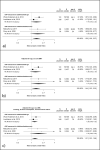Longitudinal association between CRP levels and risk of psychosis: a meta-analysis of population-based cohort studies
- PMID: 34050185
- PMCID: PMC8163886
- DOI: 10.1038/s41537-021-00161-4
Longitudinal association between CRP levels and risk of psychosis: a meta-analysis of population-based cohort studies
Abstract
Meta-analyses of cross-sectional studies suggest that patients with psychosis have higher circulating levels of C-reactive protein (CRP) compared with healthy controls; however, cause and effect is unclear. We examined the prospective association between CRP levels and subsequent risk of developing a psychotic disorder by conducting a systematic review and meta-analysis of population-based cohort studies. Databases were searched for prospective studies of CRP and psychosis. We obtained unpublished results, including adjustment for age, sex, body mass index, smoking, alcohol use, and socioeconomic status and suspected infection (CRP > 10 mg/L). Based on random effect meta-analysis of 89,792 participants (494 incident cases of psychosis at follow-up), the pooled odds ratio (OR) for psychosis for participants with high (>3 mg/L), as compared to low (≤3 mg/L) CRP levels at baseline was 1.50 (95% confidence interval [CI], 1.09-2.07). Evidence for this association remained after adjusting for potential confounders (adjusted OR [aOR] = 1.31; 95% CI, 1.03-1.66). After excluding participants with suspected infection, the OR for psychosis was 1.36 (95% CI, 1.06-1.74), but the association attenuated after controlling for confounders (aOR = 1.23; 95% CI, 0.95-1.60). Using CRP as a continuous variable, the pooled OR for psychosis per standard deviation increase in log(CRP) was 1.11 (95% CI, 0.93-1.34), and this association further attenuated after controlling for confounders (aOR = 1.07; 95% CI, 0.90-1.27) and excluding participants with suspected infection (aOR = 1.07; 95% CI, 0.92-1.24). There was no association using CRP as a categorical variable (low, medium or high). While we provide some evidence of a longitudinal association between high CRP (>3 mg/L) and psychosis, larger studies are required to enable definitive conclusions.
Conflict of interest statement
The authors declare no competing interests.
Figures


Similar articles
-
Folic acid supplementation and malaria susceptibility and severity among people taking antifolate antimalarial drugs in endemic areas.Cochrane Database Syst Rev. 2022 Feb 1;2(2022):CD014217. doi: 10.1002/14651858.CD014217. Cochrane Database Syst Rev. 2022. PMID: 36321557 Free PMC article.
-
Serum C-reactive protein in adolescence and risk of schizophrenia in adulthood: A prospective birth cohort study.Brain Behav Immun. 2017 Jan;59:253-259. doi: 10.1016/j.bbi.2016.09.008. Epub 2016 Sep 10. Brain Behav Immun. 2017. PMID: 27622678 Free PMC article.
-
Association of serum interleukin 6 and C-reactive protein in childhood with depression and psychosis in young adult life: a population-based longitudinal study.JAMA Psychiatry. 2014 Oct;71(10):1121-8. doi: 10.1001/jamapsychiatry.2014.1332. JAMA Psychiatry. 2014. PMID: 25133871 Free PMC article.
-
Longitudinal Trends in Childhood Insulin Levels and Body Mass Index and Associations With Risks of Psychosis and Depression in Young Adults.JAMA Psychiatry. 2021 Apr 1;78(4):416-425. doi: 10.1001/jamapsychiatry.2020.4180. JAMA Psychiatry. 2021. PMID: 33439216 Free PMC article.
-
Does physical activity reduce the risk of psychosis? A systematic review and meta-analysis of prospective studies.Psychiatry Res. 2020 Feb;284:112675. doi: 10.1016/j.psychres.2019.112675. Epub 2019 Nov 14. Psychiatry Res. 2020. PMID: 31757637
Cited by
-
Immune System Abnormalities in Schizophrenia: An Integrative View and Translational Perspectives.Front Psychiatry. 2022 Apr 25;13:880568. doi: 10.3389/fpsyt.2022.880568. eCollection 2022. Front Psychiatry. 2022. PMID: 35546942 Free PMC article.
-
Role and Perspectives of Inflammation and C-Reactive Protein (CRP) in Psychosis: An Economic and Widespread Tool for Assessing the Disease.Int J Mol Sci. 2021 Dec 2;22(23):13032. doi: 10.3390/ijms222313032. Int J Mol Sci. 2021. PMID: 34884840 Free PMC article. Review.
-
Mitochondria-wide association study observed significant interactions of mitochondrial respiratory and the inflammatory in the development of anxiety and depression.Transl Psychiatry. 2023 Jun 21;13(1):216. doi: 10.1038/s41398-023-02518-y. Transl Psychiatry. 2023. PMID: 37344456 Free PMC article.
-
Genetic evidence for causal effects of immune dysfunction in psychiatric disorders: where are we?Transl Psychiatry. 2024 Jan 26;14(1):63. doi: 10.1038/s41398-024-02778-2. Transl Psychiatry. 2024. PMID: 38272880 Free PMC article. Review.
-
Immune-neuroendocrine crosstalk in mood and psychotic disorders: A meta-analysis and systematic review.Brain Behav Immun Health. 2025 Feb 11;44:100965. doi: 10.1016/j.bbih.2025.100965. eCollection 2025 Mar. Brain Behav Immun Health. 2025. PMID: 40040865 Free PMC article. Review.
References
Publication types
Grants and funding
LinkOut - more resources
Full Text Sources
Other Literature Sources
Research Materials
Miscellaneous

